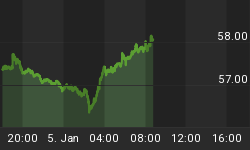While I don't base my investment or trading strategy on the ability to use a crystal ball, I thought it would be fun to look ahead and see what the technical tea leaves have in store for 2007.
Analysts Are Bullish
As 2006 winds down, market strategists are looking ahead to 2007, and as can be seen from the Business Week Online Fearless Forecast, the expectations are rather rosy. Of the 80 analysts polled, almost 90% expect the S&P500 to end 2007 higher than its current level of 1400. Two thirds of these strategists prognosticate the S&P500 to be above 1500 by year's end.
Often times in trading and investing it is not the destination that is important but how we arrived at that point that makes the difference in our results. For example, the markets can have a down year, but as traders (as opposed to buy and holders), we are able to capture profits from the market's swings. With this in mind, of the 73 analysts who had an opinion about where the markets would be mid year, 80% thought the S&P500 would be higher than 1400.
So with strategists expecting very little downside and a somewhat bullish upside, the contrarian in me says, "Hold on here. We all know how the market will do its best to frustrate those with the prevailing opinion."
With so many lined up on one side of the prognosticating ledger, I am often reminded of the race horse Smarty Jones. After having won the first two legs of the Triple Crown in 2004, Smarty Jones was the odds on favorite to win the Belmont Stakes. As a matter of fact, he was such sure bet that it probably wasn't worth showing up at the track that day to bet on him. In other words, why risk money on Smarty Jones at all when the payoff was so little.
As it turned out, Smarty Jones came in second that day to Birdstone, a 36-1 to favorite, providing a handsome payoff for those willing to step outside the expectations of the masses and bet on a long shot.
And as I look out to 2007, the bullishness of the herd and the story of Smarty Jones has me thinking, "go the other way." But it is more than just being contrary for the sake of being contrary as my interpretation of the charts is somewhat bearish.
S&P500
Figure 1 is a monthly chart of the S&P500. There is a significant resistance zone between 1439 and 1478 that I believe will cap any upside move for 2007. With the S&P500 near 1400, this only leaves about a 6% upside.
Figure 1. S&P500/monthly
Another reason to believe that this resistance level will be tough to break through is the fact that price projections from the inverted head and shoulders bottoming pattern end right in that resistance zone.
As markets tend to retrace prior price moves, I believe that the S&P500 during 2007 will retrace at least 38% of the prior bull market move from the October, 2002 lows. This will carry the S&P500 down to the 1230 level. A 50% retracement will bring price to the 1150 level. It should also be noted that the S&P500 has not had a pullback of greater than 10% in over 4 years, which is one of the longest periods in history. A retracement of 38% from the projected resistance would represent about a 15% drop in the S&P500.
In sum for the S&P500, I see a 6% upside and 15% downside.
Dow Industrials
A monthly chart of the Dow Industrials is shown in figure 2. From the October, 2002
Figure 2. Dow Industrials/ monthly
lows to the February, 2004 highs, the Dow traveled approximately 2800 points. Prices then consolidated over the next 21 months (yellow rectangle). The breakout from this consolidation should lead to a measured move where the current gains should be equal to gains seen off the October, 2002 bottom. Utilizing this methodology, the current price move on the Dow should begin to encounter resistance around 12,900. With the Dow currently at 12,400 this is only a 4% upside for this index.
If the broader market sells off, I expect the support levels to be tested. This is around 11,250 on the Dow; a secondary level of support would be at 10,600 which was the break out from the 21 month consolidation period.
If the Dow were to reach the price projection as predicted by the measured move and then sell off to support levels at 11,250, this would then represent an approximately 13% loss from the highs, which would be within the confines of the ranges seen on the S&P500.
In sum for the Dow, I see a 4% upside and a 13% downside.
NASDAQ
The NASDAQ is my real wildcard and the toughest chart for me to interpret because it is lagging the other major indices so much. See figure 3 a monthly chart.
Figure 3. NASDAQ/ monthly
Utilizing the methodologies described above to make a price projection, the NASDAQ could make it to the 2900 level. With the NASDAQ currently at 2400, this is over 20% away. The issue remains significant resistance at the 2500 level that should be difficult to overcome while the index is overbought and bullishness abounds.
Support for the NASDAQ is between 2067 and 2150.
In sum for the NASDAQ, I see a 2% upside and a 15% downside. There is the possibility that the NASDAQ could trade to 2900 and that would really be a bullish surprise, and it would certainly portend well for the overall market. However, when looking at some of the sectors that we normally associate with the NASDAQ -i.e., the internets, semiconductors and biotech - I see more trouble ahead for the markets.
And that will be part 2 of this commentary.















